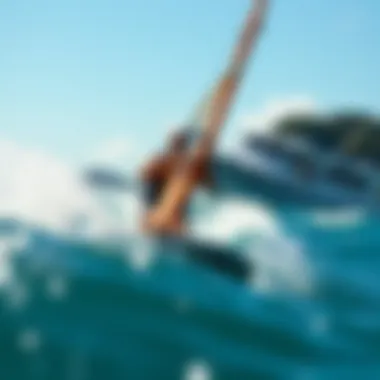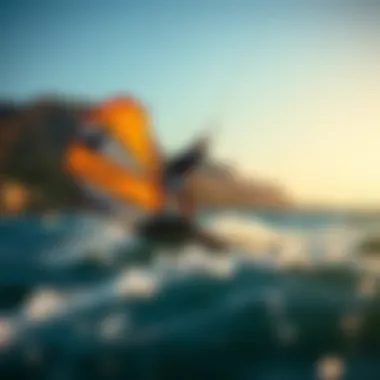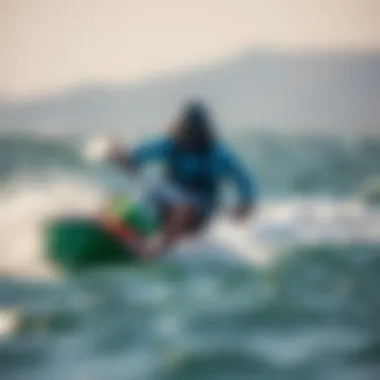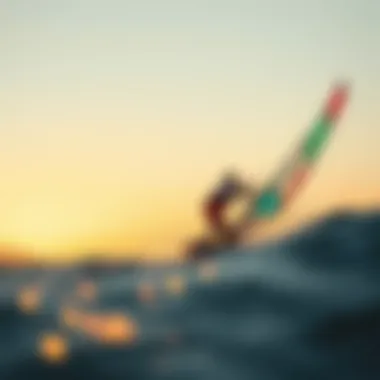Understanding Wind Direction for Watersports Success


Intro
In the realm of watersports, wind direction is a crucial factor that can make or break your adventure. Whether you're on a surfboard, sailing a yacht, or riding a jet ski, understanding how the wind interacts with water can greatly influence your experience. This article dives into the nuances of wind direction and its importance for enthusiasts at all levels. From understanding wind patterns to practical tips that can enhance your time on the water, this guide serves as a valuable resource for athletes, coaches, travel agents, bloggers, and educators alike.
Tips and Techniques
Beginner Tips for Watersports
For those just starting, grasping the basics of wind direction can feel like trying to catch smoke with your bare hands. However, a few fundamental tips can ease your journey:
- Observe before you venture out: Spend a little time watching the wind's effect on the water. Look for ripples, wave shapes, and the movement of other sailors or surfers.
- Wind direction matters more than strength: Beginners often focus on wind speed, but knowing where the wind is coming from can be more impactful. A side-on wind can be perfect for surfing, while a headwind can create challenges.
- Choose the right time of day: Early mornings often present calmer winds, while afternoons might kick up stronger breezes. Knowing the typical wind patterns in your area can help you plan your outings effectively.
Advanced Techniques for Mastery
For the seasoned watersports enthusiast, mastering wind dynamics can elevate performance to the next level. Here are some advanced strategies to consider:
- Use wind predictions and forecasts: Utilize online resources like Windy.com or NOAA.gov to obtain accurate wind forecasts. A well-timed session can result in significantly better conditions.
- Understand thermal winds: These winds occur due to temperature differences between land and water. Learning when thermal breezes typically rise can create optimal conditions for sailing and other activities.
- Practice shifting gears: During your ride, practice adjusting your technique based on changing wind conditions. Learning how to maneuver seamlessly can boost performance and enhance enjoyment.
Safety and Gear
Essential Safety Practices
Safety should always be the top priority when engaging in watersports. Here are key practices to ensure a secure experience:
- Wear appropriate life jackets: Regardless of skill level, a life jacket should always be worn. It offers not just safety but also peace of mind.
- Check your equipment regularly: Before heading out, inspect your gear to ensure everything is functioning properly. This includes checking for wear and tear on sails, boards, or personal flotation devices.
- Know the body of water: Familiarize yourself with local hazards, currents, and weather patterns. This knowledge can be the difference between a thrilling adventure and a dangerous situation.
Gear Reviews and Recommendations
Investing in the right gear can significantly affect your enjoyment and safety. Here's a look at some recommended equipment:
- Wetsuits: If you're surfing in cooler waters, a high-quality wetsuit, like those offered by O'Neill or Rip Curl, ensures warmth and flexibility.
- Sails and Boards: For sailors, brands like Hobie and North Sails provide excellent options that cater to various wind conditions.
- Life Jackets: Consider comfortable, low-profile options from brands like MTI or Onyx that won’t hinder movement.
"Understanding wind direction isn't just a mere skill, it's an art form that every watersports lover can master."
By diving into the world of wind and water, enthusiasts can greatly enhance their skills, enjoyment, and ultimately, their safety on the water. From novice tips to advanced techniques, keeping an eye on today's wind direction can keep the thrill alive in every venture.
The Importance of Wind Direction in Watersports
Understanding wind direction is crucial for anyone engaged in watersports. Whether you are gliding over waves on a surfboard, steering a sailboat, or racing a jet ski, the wind plays a powerful role in your experience. Effective navigation and performance often hinge on an astute awareness of wind patterns.
Benefits of Knowing Wind Direction:
- Enhanced Performance: Watersport athletes can maximize their skill application and control when they understand how wind affects their chosen activity.
- Safety Precautions: Being aware of wind shifts can significantly reduce risks associated with strong gusts that may catch enthusiasts off guard.
- Optimized Conditions: Recognizing favorable wind conditions can lead to better opportunities on the water, allowing individuals to time their outings around prime conditions.
Effective preparation is as vital as physical skill when engaging in these activities. To make the most out of every trip, knowledge about wind direction should be treated as part of the groundwork, akin to learning about tides or current behavior.
Preamble to Wind Effects
Wind is more than a mere background element; it is a primary catalyst for water dynamics. From choppy waves to smooth surfaces, wind influences how watersports unfold. Variable wind speeds can either energize sails or create undesirable conditions for a kite surfer hovering over the water.
Understanding the effects of wind starts with its interaction with the water surface. For example, a light breeze can barely ruffle the water, creating ideally calm conditions for beginners, while a stronger wind can lead to dramatic surf, challenging even the most experienced surfers.
In different cases, the impact of wind is seldom uniform. Coastal areas might feature more turbulent wind conditions due to geographical formations that funnel wind, while open waters may experience steadier breezes. Therefore, assessing the landscape in conjunction with knowing wind direction enhances overall safety and enjoyment.
How Wind Shapes Water Conditions
Wind shapes water surfaces in distinct ways. The transformation is both visual and physical, impacting everything from wave formation to stability in sailing. For example, on a flat day, the surface might appear like glass, providing distinct comfort for paddleboarders and swimmers, while unpredictable gusts can produce chop that disrupts motion altogether.
Here are a few ways in which wind influences water conditions:
- Wave Formation: Wind generates waves through friction with the water surface. The faster the wind blows, the larger and more powerful the waves can become.
- Direction of Swells: Sailing or surfing relies on understanding wave direction, which is often a direct result of prevailing winds. Knowing where these waves are coming from helps athletes position themselves better.
- Water Current Dynamics: Wind can create currents that impact how water flows near shores or into anchorage areas, leading to unpredictable situations if not properly understood.
When organizing an outing focused on watersports, consider that each session's characteristics will change based on prevailing and variable wind conditions. Successful navigation depends not just on task-based skill but an intrinsic understanding of wind-driven water dynamics.


Current Wind Patterns: An Overview
Understanding wind patterns is crucial for watersports enthusiasts seeking to maximize their time on the water. Wind affects not only the surface conditions of the water but also the overall experience of activities such as surfing, sailing, and jet skiing. It’s not just about finding a good wave or a steady breeze; it’s about timing your activities to fit the natural rhythms of the environment. Without a grasp on current wind patterns, an enthusiastic day on the water can quickly turn frustrating.
Forecasting Today's Wind Direction
Knowing how to forecast today's wind direction is an invaluable skill for any athlete. It's akin to reading the pulse of the environment. Various factors come into play, such as geographic location, time of year, and even local weather trends.
- Local Conditions: Each area has its unique wind patterns. For instance, coastal regions often experience sea breezes that can shift throughout the day, creating ideal conditions for sailing or jet skiing. Conversely, those new to surfing might find that offshore winds create cleaner, more manageable waves. Understanding these local quirks is key.
- Weather Fronts: A cold front passing through, for example, can significantly alter wind direction and intensity. Staying informed about these shifts through weather services can help enthusiasts anticipate these changes. The National Weather Service (weather.gov) provides excellent resources for forecasting.
- Real-time Data: Utilizing online platforms or apps that provide live data can guide immediate decisions on where and when to hit the water. This means less guesswork and more enjoyment.
Tools for Getting Accurate Wind Data
Technological advancements have provided many tools to help enthusiasts monitor wind conditions effectively.
- Weather Apps: Apps such as Windy or Windy.app offer real-time updates and detailed maps that show wind patterns and forecasts. They give users a look at how wind speed and direction will change throughout the day.
- Anemometers: Professionals often use anemometers - devices that measure wind speed and direction. For those who prefer a more hands-on approach, investing in a handheld anemometer can help gauge conditions directly.
- Local Reports: Local sailing or surfing clubs often post wind reports, including real-time updates that can be more reliable than generalized forecasts. Following local experts on social media platforms like Facebook or Reddit can keep enthusiasts in the loop about wind conditions in their area.
Even a small change in wind can have a huge impact on water sports. By staying informed and utilizing available tools, watersport enthusiasts can make more calculated decisions, ultimately improving both safety and enjoyment on the water.
"The wind is one of nature's most elusive elements, yet grasping its behavior can unlock a world of adventure on the water."
Monitoring wind patterns effectively fosters both an enjoyable and safe experience. Whether you are a seasoned surfer or a novice in sailing, becoming attuned to wind behavior can elevate your skills and enjoyment in the ever-changing aquatic landscape.
Impact of Wind Direction on Surfing
Understanding the impact of wind direction on surfing is crucial for anyone serious about riding the waves. The wind doesn't just affect surface conditions; it influences the overall experience of surfing. A keen awareness of wind patterns can set an individual apart, whether they are a beginner or an experienced rider. By navigating the complexities of wind physics and their effects on water dynamics, surfers can appreciate the subtleties of their environment.
The importance of understanding wind direction lies in how it interacts with ocean currents and local geography. For instance, certain beaches may exhibit varied wave quality depending on the wind's angle. A side-onshore wind might flatten the waves, making them less ideal for riding, while an offshore wind can amplify wave size and shape, creating perfect surf conditions.
Key considerations for surfers include:
- Wind speed: A gentle breeze is usually ideal. Winds that are too strong can create chaotic conditions that may lead to dangerous waves.
- Wind direction: Offshore winds tend to hold waves up longer, while onshore winds can break them up quickly.
By keeping these factors in mind, surfers can enhance their chances of finding optimal riding conditions, allowing for a more fulfilling session on the water.
Optimal Wind Conditions for Surfing
When it comes to optimal wind conditions, the general rule of thumb for surfers is to seek out offshore winds. Offshore winds blow from the land towards the sea, enabling waves to stand up and maintain their shape, resulting in cleaner, more ridable waves. Conversely, an onshore wind blows from the ocean onto the shore, leading to choppy and less predictable surf.
Moreover, the ideal wind conditions typically include:
- Moderate wind speeds: Winds in the range of 5 to 15 knots are often considered perfect for surfing.
- Timing the wind: Early mornings or late afternoons often present these conditions when winds are generally calmer.
- Checking forecasts: Utilizing reliable wind forecasting tools can give surfers a leg-up in planning their sessions.
Thus, understanding local wind conditions not only helps to improve performance but also ensures safety while out on the waves.
How Wind Influences Wave Quality
Wind has a profound influence on wave quality, shaping the surfing experience in various ways. Quality waves are defined by their height, shape, and consistency. These aspects can be highly susceptible to even the slightest changes in wind direction or speed.
Consider these factors regarding wave quality:
- Wave height: Offshore winds tend to produce taller, steeper waves.
- Wave shape: The wind's interaction with a wave as it breaks determines how surfable it will be. A good wind direction can create powerful, well-defined waves that provide better rides.
- Consistency: A steady breeze contributes to a coastline's wave consistency, allowing for prolonged surf sessions without drastic condition changes.
"Understanding how wind influences wave quality is akin to learning the language of the sea, and once you grasp it, every session transforms into a dialogue with nature."
In short, wind direction is a fundamental aspect of surfing that can either make or break a session. With knowledge and experience in assessing wind effects, surfers can optimize their time in the water, ensuring they ride the best waves possible.
Navigating Sailing with Awareness of Wind
Understanding the wind's behavior is paramount for any sailor. With the right knowledge, one can harness the wind effectively, making for a more pleasurable and efficient sailing experience. This section aims to shed light on how a sailor can navigate the intricate dance of wind direction, fostering not just safety but also an exhilarating ride on the waves.
Understanding Sailboat Maneuverability
Sailboats operate on a delicate interplay of sails and wind. The design of the sailboat itself allows it to take advantage of wind patterns. Sailboats can move in multiple directions relative to the wind—into the wind, with the wind, and at different angles to the wind.
- Control Surfaces: The rudder and keel play significant roles in how a sailboat maneuvers. They provide stability and control, allowing sailors to steer effectively and maintain their desired course.
- Sail Adjustments: Shaping sails properly can make all the difference. Whether it’s reefing the sails in stronger winds or easing them off when the wind lightens, adjustments are crucial.
- Points of Sail: Understanding the relative position of the wind can also influence how maneuverable a sailboat is. From beating to running, each point of sail demands different techniques and sail configurations.


Navigating a sailboat is not just about steering; it entails making continuous decisions based on wind direction, sail trim, and boat handling skills. By understanding how these elements come together, sailors can tackle various water conditions with confidence.
Adjusting to Changing Wind Directions
Wind is notoriously fickle. For anyone who has braved the open sea, you may have noticed how winds can shift, sometimes rather abruptly. This unpredictability can pose a challenge, but also provides an opportunity for seasoned sailors to put their skills to the test.
When faced with changing wind conditions, keeping a cool head and a keen eye is essential. Here are some strategies to adapt effectively:
- Watch for Visual Indicators: Observing the water surface can reveal much about the wind. Ripples, wave patterns, and the behavior of other vessels can offer clues about shifting currents.
- Reassess Your Course Regularly: Regularly check whether your current course remains optimal. Is the wind direction still favorable? If not, don’t hesitate to adjust your sails or course to best utilize the wind.
- Practice Quick Reactions: Developing the ability to quickly react to changing conditions is a skill that can take time to cultivate. Practicing your responses in varied conditions can prepare you for the wear and tear of actual sailing.
- Stay Informed: Using tools like wind meters or apps designed for sailors can offer valuable data on upcoming wind shifts. This approach not only helps improve decision-making but also enhances safety.
A well-prepared sailor who understands wind behavior can turn what could be a dangerous situation into an exciting adventure.
Jet Skiing and Wind: A Safety Perspective
Jet skiing is a thrilling watersport that combines speed and the open water's expansive allure. However, it doesn't come without its challenges, especially when the wind plays a pivotal role. Understanding wind's impact on jet skiing is not just beneficial but downright necessary for safety and optimum performance.
Wind Hazards for Jet Ski Operators
When you’re skimming across the water on a jet ski, the wind can act as both your friend and foe. High winds can lead to hazardous conditions that put riders at risk. Here are some key factors to consider:
- Increased Waves: Strong winds can create larger waves and rougher water. This not only makes maneuverability harder but also raises the chance of capsizing. A sudden gust can take you aback, throwing you off balance.
- Reduced Visibility: Wind-driven spray can cut down visibility drastically. It’s one thing to cruise with clear sight; it’s whole other ballgame when you can’t see what’s ahead.
- Choppy Waters: When the wind is up, it makes for choppy waters. Consistent bouncing can lead to fatigue, and if you're not careful, that fatigue can sway your control over the jet ski.
Making fantastic decisions out on the water means tuning into weather reports and wind forecasts before hitting the waves. Even if the sun is shining, those wind patterns can take a nasty turn without much warning.
Adjusting Speed to Wind Conditions
Understanding the relationship between wind and speed is like knowing how to dance—the smoother you are, the better you perform. Here’s how speed and wind affect jet skiing performance:
- Speed Management: When wind gusts are particularly aggressive, slowing down might be your best bet. If the wind picks up, controlling your jet ski while moving at high speeds becomes tougher, increasing the likelihood of accidents.
- Finding the Sweet Spot: Riders should find a balance between speed and wind resistance. You want to enjoy the rush but retain control. Too slow, and you risk instability, too fast in rough conditions and you face the risk of losing control.
- Trim Adjustments: Knowing how to adjust your trim can help you ride with better stability. By altering your ski’s trim setting, you can effectively counter the wind's negative effects and maintain a smoother ride.
Wind Direction Across Different Regions
Understanding how wind direction varies across different regions is crucial for watersports enthusiasts. Not only does this knowledge help in selecting the right location for an adventure, but it also enhances safety and performance on the water. Different areas feature unique wind patterns that can greatly influence water conditions, wave heights, and even the temperature of the water. Such variations become particularly significant in making the best choices for activities like sailing, surfing, and jet skiing.
Regional Variations in Wind Patterns
Wind doesn’t just blow in one direction; it dances and swirls based on local geography, climate, and time of year. The first thing to grasp is that regions are influenced by several factors:
- Topography: Mountains, valleys, and other geographical features can create wind channels and blockages, significantly altering wind patterns. For instance, areas surrounded by high cliffs may experience unpredictable gusts.
- Body of Water: Proximity to oceans, lakes, and rivers can affect wind direction. For example, coastal areas often deal with sea breezes, which are cooler winds that blow from the water onto land.
- Weather Systems: High and low-pressure systems can dictate the directions winds take. Fronts often bring sudden changes in wind direction, affecting water conditions almost immediately.
Understanding these regional variations allows watersports enthusiasts to adapt their activities accordingly. For example, if you're surfing in Hawaii, you might expect the trade winds from the northeast to create ideal conditions. Alternatively, in the Great Lakes region, seasonal wind shifts can lead to dramatically different wave quality from summer to winter.
How Geography Affects Wind Direction
Geographical features directly influence wind direction in profound ways. The plains of the Midwest, the coastal ranges, and the hilly outcrops all have their own wind behaviors. Here are some key considerations:
- Mountains and Ridges: These can create a phenomenon known as a 'mountain wave'. When winds hit a mountain, they can lift, causing turbulent air patterns. Watersports enthusiasts should be aware that these conditions may lead to unpredictable swells and chop, especially when sailing or jet skiing.
- Valleys: In valley regions, wind can funnel efficiently, resulting in much stronger currents than might be expected. The wind tends to curve and accelerate as it moves through these natural corridors.
- Coastal Areas: The interaction of land and sea creates significant variations in wind conditions. On hot days, the land heats up faster than the water, causing the wind to shift towards the cooler lake or ocean. This phenomenon is particularly important for anyone planning to sail or surf near coasts.
So whether you’re gearing up for a kiteboarding session in the Caribbean or planning a kayaking trip in the Pacific Northwest, recognizing the geographical quirks of each locale can mean the difference between a thrilling adventure and a treacherous outing.
"Mastery of local wind patterns isn’t just a skill; it’s essential for maximizing your enjoyment and safety on the water."
Depending on where you head out, the wind can become your best friend or your worst nightmare, so take the time to learn and adapt accordingly.
Practical Tips for Watersport Activities Today
When it comes to enjoying watersports to their fullest, understanding the wind direction can bridge the gap between a good day on the water and a great one. Knowing how to align your activities with current wind conditions not only enhances performance but also boosts safety and enjoyment. Consider these practical tips when planning your next adventure.
Selecting Your Watersport Based on Wind
Choosing the right watersport in relation to wind can make all the difference in your experience. Different activities thrive under varied wind conditions, and understanding these can set you up for success:
- Surfing: Ideal for days when the wind comes from the shore, as this leads to clean, well-formed waves. On the flip side, offshore winds tend to flatten surf, making it less favorable.
- Sailing: Dependent on consistent winds, many sailors prefer a steady breeze in the range of 10 to 15 knots. Too little wind can stall a boat, while gale-force winds can lead to danger.
- Kitesurfing and Windsurfing: These sports flourish in strong winds; however, excessive wind can be hazardous. A good rule of thumb is to check reports indicating wind speed between 15 to 25 knots for optimal conditions.
- Jet Skiing: While slightly less affected than other sports, choppy water caused by wind can make for a bumpy ride. If the winds are too strong, it’s better to wait for calmer conditions.
Understanding the ideal wind conditions for your chosen sport not only prepares you better but also helps you avoid disappointment.


Adapting Your Technique to Wind Conditions
Once you’re out on the water, adapting your technique to the prevailing wind conditions can significantly affect your overall performance. Here are a few ways to adjust:
- For Surfing: When experiencing onshore winds, focus on your positioning on the wave. Staying closer to the peak could yield better rides, avoiding the flatter areas created by the wind.
- Sailing Adjustments: Trim your sails to suit the wind. In lighter winds, sails should be set deep for maximum surface area, whereas in stronger winds, flattening the sail can decrease drag and increase speed.
- Jet Ski Riding: Watch for wind-driven waves; a change in technique can reduce the risk of capsizing. Leaning into waves helps maintain control.
"Wind can be your best friend or your fiercest foe. Knowing how to read it and adapt can elevate your entire experience on the water."
By keeping a keen eye on wind patterns and adjusting your technique accordingly, you not only ensure a safer experience but also maximize the enjoyment of your time in the water. Embrace the elements; let the wind guide your path to success in watersports.
The Science Behind Wind Direction
Understanding wind direction isn't just a science; it's the backbone of effective watersport activities. Knowing how and why wind behaves the way it does can make or break the experience on the water.
Wind direction impacts every aspect of water sports. From sailing smoothly across a lake to riding the perfect wave while surfing, the way the wind moves plays a pivotal role. Not only does it affect water conditions, but it also impacts safety measures, performance, and the overall dynamics of aquatic environments.
In essence, by grasping the science behind wind, watersports enthusiasts can maximize their fun while minimizing risks associated with unpredictable weather patterns.
Understanding Wind Patterns and Meteorology
At its core, wind is the result of air movement caused by differences in atmospheric pressure, temperature, and geographical features. Understanding these basics not only enhances a watersport athlete's experience but also acts as a crucial protective measure.
Several factors contribute to how winds form:
- Temperature Differences: Warm air rises, creating low pressure, while cooler air sinks, creating high pressure. These variations lead to wind.
- Geography: Mountains, valleys, and bodies of water all influence local wind patterns. For instance, coastal areas may experience sea breezes due to temperature differentials between land and water.
- Weather Systems: Large-scale phenomena like fronts or storms can significantly affect local winds.
To really make sense of how wind behaves on any given day, enthusiasts should keep an eye on weather patterns through reliable meteorological resources. Accurate forecasts provide invaluable data on expected wind directions, intensities, and other relevant conditions.
Wind Measurement Techniques
Getting reliable wind data is downright crucial for any watersports activity, yet many enthusiasts overlook this detail. By employing proper measurement techniques, one can better predict conditions before hitting the water. Here are some techniques to consider:
- Anemometers: Instruments specifically designed to measure wind speed and direction. Whether handheld or mounted, they provide accurate real-time data.
- Weather Stations: Localized weather stations report wind conditions using sensors that capture and relay important information. These can often be accessed online through governmental or educational resources
(weather.gov). - Mobile Applications: There are numerous apps available today that provide real-time wind data specific to your location. Such convenience can mean the difference between a pleasant day on the water or unfavorable conditions.
By understanding these methods, watersports enthusiasts can gather critical information that can be used to their advantage, paving the way for safer and more enjoyable outings.
Wind and Weather: A Correlation
Understanding the interrelationship between wind and weather serves as a cornerstone for watersports enthusiasts. Wind not only shapes the experience on the water but also drives the overall weather systems that affect aquatic activities. The dynamics of wind directly correlate with various meteorological phenomena, prompting wise decisions for those who partake in surfing, sailing, or jet skiing.
Wind Direction and Cloud Formation
The direction of the wind plays a pivotal role in determining cloud formation. When the wind blows from a specific direction, it carries moisture and temperature changes that significantly affect cloud characteristics. For instance, when warm air rises, it cools down, leading to condensation and the formation of clouds. Observing wind patterns can thus offer insights into expected weather conditions.
- Onshore Winds: These blow from the sea towards the land, often bringing moist air, which can lead to cloud formation and even precipitation. This can enhance the surfing conditions by creating larger waves but also indicates potential storms or bad weather.
- Offshore Winds: Winds blowing from the land towards the sea can clear the skies. This may signal a more stable environment on the water, possibly ideal for sailing but can also cause a decrease in wave activity, affecting surfers' plans.
In effect, understanding wind direction is not merely a curiosity but a practical approach for athletes and hobbyists to predict their immediate environment. Cloud types, such as cumulus or stratus, can often hint at the changing weather, thereby influencing the planning of watersport activities.
Impact on Temperature and Precipitation
Wind direction significantly affects local temperatures and the distribution of precipitation. It acts as a conveyor belt for thermal conditions, transporting air masses that can lead to warming or cooling effects over a given area.
For example:
- Cold Fronts: When winds shift from the north, they can bring cold air, leading to swift temperature drops. Such conditions could make watersport activities less favorable, particularly in the cooler months.
- Warm Fronts: Conversely, winds originating from the south often carry heat, raising temperatures. This can extend the seasons for various activities, making warmer waters more inviting for enthusiasts.
Moreover, precipitation patterns are closely linked to wind directions. Persistent onshore winds may cause increased rainfall, which can lead to rougher water conditions—something essential for surfers and sailors to consider.
"Understanding wind patterns not only enhances your aquatic experience but fortifies your safety and enjoyment."
By comprehending the relationship between wind and weather, watersports enthusiasts can improve their planning and decision-making. Familiarity with how wind shapes temperature and precipitation allows for a more informed, safer, and ultimately more gratifying adventure on the water.
Culmination: Harnessing Today's Wind for Optimal Experience
Mastering the wind's behavior is paramount for those engaged in watersports. For serious enthusiasts, understanding how to utilize wind direction can elevate the experience from merely enjoyable to truly remarkable. Knowing how to read the signs of wind patterns not only enhances safety but also improves performance in activities like surfing, sailing, or jet skiing.
Recap of Key Insights
Reflecting on the discussions throughout this article, it becomes evident that wind holds sway over every aspect of water-based activities. Key takeaways include:
- Wind direction matters: It can make or break a session. A favorable wind direction can lead to optimal wave conditions for surfers or smooth sailing for boats.
- Safety first: Wind can be a double-edged sword. Understanding potential hazards lets enthusiasts enjoy their activities while minimizing risks from sudden gusts or turbulent conditions.
- Adjust your techniques: Whether leaning into the wind or riding with the waves, adapting to current wind conditions is essential. For instance, surfers should adjust their angles based on how waves break in conjunction with the wind.















